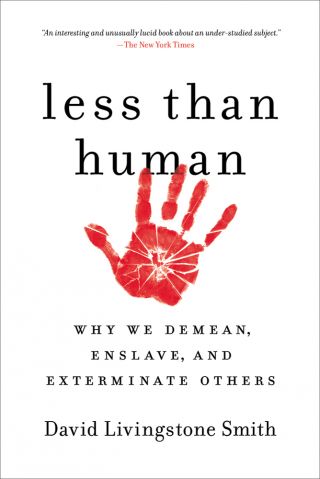
Philosophy
Pariahs as Predators, Prey, and Parasites
Review of "Less Than Human: Why We Demean, Enslave, and Exterminate Others."
Posted January 10, 2013
In Rwanda they referred to Tutsis as cockroaches. They were not human beings…[They said,] Don’t worry, you’re not killing humans like you. You are killing some vermin that belongs under your shoe. You’re killing cockroaches. (p. 152) ~ Rakiya Omaar, director of human rights organization African Rights
This is an important book. In seeking to understand the psychological roots of violence, slavery, and genocide, Less Than Human has lofty ambitions, and makes headway toward achieving them. Drawing from history, psychology, philosophy, biology, and anthropology, David Livingstone Smith weaves together a powerful argument that dehumanization facilitates our longstanding propensity to harm, enslave, and exterminate fellow humans. However, a failure to consider an adaptationist perspective prevents Less Than Human from fully illuminating our propensity to treat groups of humans inhumanely.
Author Background
Formerly a psychoanalytic therapist, Smith is now an associate professor of philosophy at the University of New England and director of the Human Nature Project. After authoring three books on psychoanalysis, Smith grew skeptical of psychotherapy and began studying philosophy of mind and philosophy of psychology (Smith, 2007). He has since written three books that explore human nature thorough the evolutionary lens.
Author’s Argument
Smith defines dehumanization as “the act of conceiving of people as subhuman creatures rather than as human beings” (p. 26). Without minimizing the marginalization of women, gays, immigrants, and the disabled, Smith opts to focus on the dehumanization of Jews, sub-Saharan Africans, and Native Americans. His writing, like his thinking, is lucid, logical, and accessible, and often quite vivid.

Early on, Smith fleshes out the importance of studying dehumanization by viewing it in the contexts of World War II and current conflicts in the Middle East. Smith details myriad examples of Germans, Japanese, and Americans referring to each other as non-human animals. This tendency to dehumanize the enemy by depicting them as subhumans is shown to continue unabated today, with members of the American military and media referring to Iranians, Iraqis, Afghanis, and terrorists as non-human animals.
Smith argues that, “dehumanization…[is] a way of thinking that, sadly, comes all too easily to us” (p. 13). The ease with which we dehumanize is exemplified in the many ways we depict others as non-human animals that elicit aggressive responses, usually predators, prey, parasites and other unclean things. Throughout the book, Smith documents how Homo sapiens have long viewed disfavored conspecifics as subhumans, and have used a long list of names when doing so. The dehumanized have been depicted as dung flies, worms, rats, leeches, lice, bacteria, bugs, rodents, insects, large armed ants, cockroaches, mice, pigs, evil weeds, garbage, slime, poisonous parasites, bacilli, maggots, dangerous microbes, germs, agents of disease, fungus, decomposing agents, vermin, swine, termites, weevils, louse, peccaries, tapirs, lizards, dogs, monkeys, apes, snakes, foxes, ravens, beasts, bees, spiders, wolves, lions, crocodiles, baboons, immense octopuses, flesh-eating monsters, demons, vampires, bloodsuckers, gorillas, hyenas, tigers, bears, cattle, cows, and hairy twisted nose savages.
Toward the end of the book, Smith concludes that we have an innate, biologically rooted bias against outsiders and that this bias “is seized upon and manipulated by indoctrination and propaganda to motivate men and women to slaughter one another” (p. 71). He surmises that dehumanization probably couldn’t exist without racism.
Failure to Consider an Adaptationist Perspective
Although Smith refers to dehumanization as being functional, namely, to override our disinclination to kill humans who have not affronted us, he does not view it as the adaptive outcome of mechanisms designed to increase one’s reproductive success. As Smith is usually careful not to overstate his case, it is quite surprising to see how adamant he is that dehumanization was not naturally selected for: “Dehumanization is not a biological adaptation. It wasn’t put in place by natural selection and it’s not hard-wired” (p. 265). Smith is unwavering in his view of dehumanization as a by-product.
In the light of adaptationism, dehumanization exhibits what Williams (1966) called evidence of special design including universality, functionality, and economy. Dehumanization develops across cultures and across generations (universality). It appears well-suited to solve the adaptive problem of overcoming our reticence to kill humans who have done us no harm, and may also serve to minimize reputational damage associated with the unwarranted killing of conspecifics (functionality). And it does all of this without huge reproductive costs for the dehumanizer (economy). A case could be made that dehumanization is improbably useful (Pinker, 1997) in that it is too precisely functional to have arisen by chance alone. Moreover, with reference to Schmitt and Pilcher’s (2004) nomological network heuristic for identifying adaptations, the evidence for dehumanization as an adaptation could be considered moderate in breath, as findings exist that fit into at least three “evidence boxes” (theoretical, psychological, and cross-cultural).
Given that natural selection is a competitive process, a suite of psychological mechanisms that appear specially designed to increase an organism’s ability to survive, thrive, and reproduce at the expense of conspecifics by debasing them is ripe for adaptationist exploration. This is particularly the case in the human organism who frequently dehumanizes the opposition during warfare and for whom warfare has been a significant selective force for thousands of generations (Choi & Bowles, 2007; Wrangham & Peterson, 1996). A glaring weakness of Less Than Human is Smith’s failure to entertain the possibility that dehumanization is adaptive.
Conclusion
Concerns over whether dehumanization is adaptive aside, Less Than Human advances a compelling argument that humans dehumanize to treat humans inhumanely. The book serves as a clarion call for further study of dehumanization and the violence, slavery, and genocide it begets. Future research would do well to explore whether our mirror neuron system is deactivated for a group of people once they have been dehumanized and whether those who exhibit less activity in their mirror systems are more likely to dehumanize others. I concur with Smith that the study of dehumanization needs to be made a top priority, and suggest that reading his important, well-written book should be one as well.
Follow me on Facebook and Twitter.
Copyright © 2013 Barry X. Kuhle. All rights reserved.
Note
A longer version of this book review was published elsewhere:
Kuhle, B. X., & Meyer, M. (2012). Pariahs as predators, prey, and parasites: A powerful argument but lacking in philosophical precision, literature coverage, and an adaptationist perspective. [Review of the book Less than human]. Journal of Social, Evolutionary, and Cultural Psychology, 6, 521-526. (Also see Smith’s reply.)
References
Choi, J-K., & Bowles, S. (2007). The coevolution of parochial altruism and war. Science, 318, 636-640.
Pinker, S. (1997). How the mind works. New York: Norton.
Schmitt, D. P., & Pilcher, J. J. (2004). Evaluating evidence of psychological adaptation: How do we know one when we see one? Psychological Science, 15, 643-649.
Smith, D. L. (2007, May 31). Who I am [Web log post].
Williams, G. C. (1966). Adaptation and natural selection. Princeton, NJ: Princeton University Press.
Wrangham, R., & Peterson, D. (1996). Demonic males: Apes and the origins of human violence. Boston: Houghton Mifflin.
Disclaimer: The views expressed in this blog do not necessarily reflect the views of Psychology Today and the University of Scranton, or my friends, family, probation officer, gut bacteria, darkest thoughts, and personal mohel.



